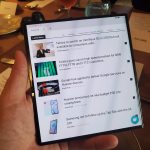Huawei’s key message for Australia? We’re not here to stay, but here to grow.
Huawei Australia’s consumer managing director Larking Huang was as clear as could be about Huawei’s intentions for the Australian market, perhaps in spite of the US trade ban of which it finds itself subject, and perhaps because of.
Despite being unable to use Google’s apps and services – which help make Android as popular as it is – Huawei will bring its newly announced Huawei Mate Xs to Australia, and its upcoming flagship P40 series will be coming to Australia too.
Having invested some $US3 billion into growing its App Gallery offering to meet consumer demand, the company is betting big that it will be able to offer enough to make its mobiles popular in the western markets it wants to (re)crack into.
And, having used the new Huawei Mate Xs last night, I can only hope they’re right. Last year’s original Mate X felt fantastic, but equally, very much a first generation device.
Fast forward just twelve months, and the Mate Xs feels like the finished product; folded, it feels as well constructed as a slightly fat P30 Pro. Unfolded, it no longer feels all that fragile – rather, it’s stronger, firmer, and more solid. It feels like it should.
However, don’t get too excited – that price tag is likely to be significant, making this a definite enthusiasts device rather than a mainstream seller.
Having announced it just this last week, the Huawei Mate Xs has made the trip to Sydney, and a group of tech journos – oneself included – got some hands on time over dinner. Let me tell you, dinner was great, but the phone was better – as I noted above, this is a 2nd generation product that feels 3rd or 4th. It’s ready for retail, and ready for consumers who mightn’t be especially gentle with it either.
With pre-sales to open up next month, ahead of sales in April, the Huawei Mate Xs will retail for around the $3,999 mark, making it among the most expensive smartphones released (at least, excluding those made of gold). It’s a curious comparison that, given the ultra-thin (and tough as nails) covering on the flexible screen is described by Huawei CEO Richard Yu as worth more than gold.
Will it be worth the money? A tough question to answer, as $4,000 buys you a hell of a lot. A super top-end business grade laptop, a car, a motorbike, or an awful lot of booze. Whatever the case, this will be a luxury purchase at this price point, and I suspect Huawei mightn’t sell all that many in Australia, especially without Google services.
The hardware is top notch. The screen is beautiful, it feels solid and sturdy in the hand, and it looks and feels great. The camera is capable – the same super-sensing technology from the P series is found here – and the screen beautiful to consume content with.
However, the $3,999 question is exactly what content you’ll be able to consume. Will Huawei nail a deal with Netflix, Amazon Prime, Disney+ or any of these services? Or even YouTube? It seems unlikely.
Without that lucrative licence for Google’s Mobile Services, Huawei’s Mate Xs is going to be an interesting proposition – Huawei’s own apps do a great job at the basics – calls, contacts, calendars, web browsing and so on. However, with no integration with Google accounts – which so many Android users rely on – it’s hard to see how this can compete.
The Huawei Mate Xs we played with was a pre-production unit, and so while the build was final, the software wasn’t, meaning it’s hard to know exactly what apps customers will be able to access on the $3,999 phones. Customers will be able to use web versions of apps – e.g. Facebook, Twitter, Uber, or any Google services – but this isn’t the same as native app-based support.
Don’t expect that to change in a huge hurry, though if Google succeeds in gaining an export licence for Huawei, we could see Google apps on Huawei’s newer phones sooner than not.
We look forward – as do many of our colleagues – to the opportunity to try out the Mate Xs for a proper review. It’s something I want to make work as best as possible.. but with my reliance on Google Apps, and the difficulty I’ll face in getting them to work, how that will go is unknown.
The author enjoyed dinner with Huawei Australia’s Larking Huang and some tech journalist friends last night in Sydney. Oh, we played with a Huawei Mate Xs too.









Good luck with that Huawei. I just don’t see it happening without Google services.
They’ll sell about 5 of them here and 3 will be returned because they’ll realise they can’t install the apps they want to use.
These are like fancy feature phones without the ability to install apps from the Play Store.
Huawei is pretty much dead in Australia without Google Services. Hopefully this will change in the future, as competition is great for the consumer.
Cheers
My personal preference, would be for Huawei to permanently continue to be denied access to the GApps suite.
The two Huawei devices I’ve owned in the past were such unmitigated pieces of garbage, that as far as I’m concerned, the fewer people Huawei devices can be inflicted on, the better.
So you want less competition in the Australian market because of a personal bad experience? Just out of curiosity, which devices were these? I’ve set up a fair few Huawei devices in my day and none have experienced any major issues that would make me not purchase the brand again. Sales also suggest that there wasn’t much wrong with them as they were number two in sales in Australia before the Google ban. Don’t quote me, but I think they’re in third place even after the ban. Saying all that… Have I purchased a Huawei device as my main driver?… Read more »
The overarching reason I have for wanting to see Huawei die in the market
is their Emotion UI inflicted upon Android.
The 2 abysmal devices I’ve owned were:
The Huawei Ideos Smarkit S7-104 (rebadged as the Telstra T-Touch Tab). Woefully undercapacity battery.
The Huawei Ascend Y320. Everything about it is a steaming pile of garbage. The worst problem with it was having to fight its capacitive buttons to try to get it to do what I wanted.
China was smart and had the foresight to ban Google as their population is not reliant on it whatsoever. Most of the world however could be at the mercy of a fickle and erratic US Government hellbent on sabotage of industry leaders rather than allow free market competition.